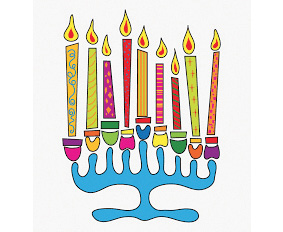According to Jewish custom, Hanukkah is considered a “minor” Jewish festival, but today it ranks—along with Passover, Purim and High Holidays—as one of the most beloved Jewish holidays, full of light and joy and family celebration.
Unlike many Jewish holidays, Hanukkah (also known as the Festival of Lights) is not mentioned in the Bible. The historical events upon which the celebration is based are recorded in Maccabees I and II, two books contained within a later collection of writings known as the Apocrypha.
As the story goes, in the year 168 B.C.E., the Syrian king Antiochus Epiphanes sent his soldiers to Jerusalem. The Syrians desecrated the Temple, the holiest place for Jews at that time. Antiochus also abolished Judaism, outlawing the observance of Shabbat and the Festivals, as well as circumcision. Altars and idols were set up for the worship of Greek gods, and he offered Jews two options: conversion or death.
On the 25th day of the Hebrew month of Kislev in 168 B.C.E., the Temple was renamed for the Greek god Zeus. A Jewish resistance movement—led by a priestly family known as the Hasmoneans, or Maccabees—developed against the cruelty of Antiochus. The head of the family was Mattathias. His son, Judah, became the chief strategist and military leader of the resistance. Though outnumbered, Judah Maccabee and his fighters miraculously won two major battles, routing the Syrians decisively.
Hanukkah evokes stirring images of Jewish valor against overwhelming odds. Other themes of the holiday include the refusal to submit to the total assimilation into Greek culture and loss of Jewish identity, and the fight for Jewish self-determination.
Hanukkah, which means “dedication,” is the festival that commemorates the purification and rededication of the Temple following the Greek occupation of that holy place. Today, the holiday reminds Jews to rededicate themselves to keeping alive the flame of Jewish religion, culture, and peoplehood so that it may be passed on to the next generation.
According to the legend, when the Maccabees entered the Temple and began to reclaim it from the Greeks, they immediately relit the ner tamid (eternal light), which burned constantly in the Temple and has a parallel in our synagogues to this day. In the Temple, they found a single jar of oil, which was sufficient for only one day. The messenger who was sent to secure additional oil took eight days to complete his mission, and miraculously, the single jar of oil continued to burn until his return. The rabbis of the Talmud attributed the eight days of Hanukkah to the miracle of this single jar of oil.
The practice of lighting the menorah (also called a hanukkiyah) became an integral part of the celebration as well as melodic Hanukkah music, games and the giving of small gifts over the eight-day holiday. Although Hanukkah became an important holiday among North American Jews, it would be incorrect to regard it as an imitation of Christmas with an emphasis on the exchange of presents. Rather, North American Jews use this holiday as a celebration of family, reinforcing Jewish identity in a place whose population may be overwhelmingly Christian but in which Jews feel at home. Hanukkah, therefore, is a means for North American Jews to feel a kinship with their neighbors, while simultaneously remembering their Jewish heritage.
